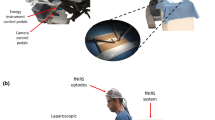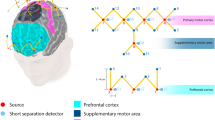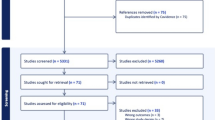Abstract
In the last decade, robotic surgery has enhanced doctors’ capabilities and enabled surgeons to operate complex procedures even through smaller incisions. Due to the increasing trend of using of robotic surgery there is a need for training the surgeons of different disciplines including urology, general surgery, gynecology, cardiovascular surgery, endocrine surgery and thoracic surgery. Training surgeons with the robotic surgery simulator (RSS) is the common and initial procedure. This study focuses on monitoring training effect of robotic surgery simulators with neurophysiological assessment via functional near-infrared spectroscopy (fNIRS) and with the embedded scoring systems of the RSS. fNIRS allow researchers to record hemodynamic responses within the prefrontal cortex (PFC) in response to stimuli. Cortical oxygenation changes of the PFC from participants were monitored while they were performing suturing tasks with various difficulty levels. Twenty four resident surgeons from two different disciplines without prior robotic surgery experience (mean age ± SD = 28.25 ± 1.98 years19 OB&GYN residents, 5 general surgery residents) completed the experimental protocol consisting of two standard training blocks. On both blocks, participants completed suture sponge tasks on three different difficulty levels. Simulator scoring provided task performance assessment of each trainee. Participants’ oxygen consumption levels were higher on the first block, where they familiarized themselves with the suturing task using RSS. On the second block, oxygen consumption levels decreased while performance scores significantly increased compared to the first block.
Access this chapter
Tax calculation will be finalised at checkout
Purchases are for personal use only
Similar content being viewed by others
References
Sridhar, A.N., Briggs, T.P., Kelly, J.D., Nathan, S.: Training in robotic surgery—an overview. Curr. Urol. Rep. 18(8), 58 (2017)
Leddy, L., Lendvay, T., Satava, R.: Robotic surgery: applications and cost effectiveness. Open Access Surg. 3, 99–107 (2010)
Van Koughnett, J.A., Jayaraman, S., Eagleson, R., Quan, D., van Wynsberghe, A., Schlachta, C.M.: Are there advantages to robotic-assisted surgery over laparoscopy from the surgeon’s perspective? J. Robot. Surg. 3(2), 79–82 (2009)
Hanly, E.J., Talamini, M.A.: Robotic abdominal surgery. Am. J. Surg. 188(4), 19–26 (2004)
Nunes, F.F., Kappaz, G.T., Franciss, M.Y., Barchi, L.C., Zilberstein, B.: Applications and economics aspects of robotic surgery. Int. J. Adv. Robot. Autom. 1(1), 1–3 (2016)
Jung, M., Morel, P., Buehler, L., Buchs, N.C., Hagen, M.E.: Robotic general surgery: current practice, evidence, and perspective. Langenbeck’s Arch. Surg. 400(3), 283–292 (2015)
Mizota, T., Dodge, V.G., Stefanidis, D.: Fundamentals of robotic surgery. In: Palazzo, F. (ed.) Fundamentals of General Surgery, pp. 215–225. Springer, Cham (2018). https://doi.org/10.1007/978-3-319-75656-1_16
Schreuder, H.W., Persson, J.E., Wolswijk, R.G., Ihse, I., Schijven, M.P., Verheijen, R.H.: Validation of a novel virtual reality simulator for robotic surgery. Sci. World J. 2014 (2014)
Andolfi, C., Umanskiy, K.: Mastering robotic surgery: where does the learning curve lead us? J. Laparoendosc. Adv. Surg. Tech. 27(5), 470–474 (2017)
Jöbsis, F.: Noninvasive, infrared monitoring of cerebral and myocardial oxygen sufficiency and circulatory parameters. Science 198, 1264–1267 (1977)
Rolfe, P.: In vivo near-infrared spectroscopy. Annu. Rev. Biomed. Eng. 2, 715–754 (2000)
Cope, M., Delpy, D.T.: System for long-term measurement of cerebral blood and tissue oxygenation on newborn infants by near infra-red transillumination. Med. Biol. Eng. Comput. 26(3), 289–294 (1988)
Izzetoglu, M., Bunce, S.C., Izzetoglu, K., Onaral, B., Pourrezaei, K.: Functional brain imaging using near-infrared technology. IEEE Eng. Med. Biol. Mag. 26, 38–46 (2007)
Ayaz, H., Shewokis, P.A., Bunce, S., Izzetoglu, K., Willems, B., Onaral, B.: Optical brain monitoring for operator training and mental workload assessment. Neuroimage 59(1), 36–47 (2012)
Aksoy, E., Izzetoglu, K., Baysoy, E., Agrali, A., Kitapcioglu, D., Onaral, B.: Performance monitoring via functional near infrared spectroscopy for virtual reality based basic life support training. Front. Neurosci. 13, 1336 (2019)
Singh, H., et al.: Robotic surgery improves technical performance and enhances prefrontal activation during high temporal demand. Ann. Biomed. Eng. 46(10), 1621–1636 (2018)
Nemani, A., et al.: Assessing bimanual motor skills with optical neuroimaging. Sci. Adv. 4(10), eaat3807 (2018)
Khoe, H.C., et al.: Use of prefrontal cortex activity as a measure of learning curve in surgical novices: results of a single blind randomised controlled trial. Surg. Endosc. 1–12 (2020)
Ohuchida, K., et al.: The frontal cortex is activated during learning of endoscopic procedures. Surg. Endosc. 23(10), 2296–2301 (2009)
Author information
Authors and Affiliations
Corresponding author
Editor information
Editors and Affiliations
Rights and permissions
Copyright information
© 2020 Springer Nature Switzerland AG
About this paper
Cite this paper
Aksoy, M.E., Izzetoglu, K., Agrali, A., Kitapcioglu, D., Gungor, M., Simsek, A. (2020). Effect of Robotic Surgery Simulators in Training Assessed by Functional Near-Infrared Spectroscopy (fNIRs). In: Schmorrow, D., Fidopiastis, C. (eds) Augmented Cognition. Human Cognition and Behavior. HCII 2020. Lecture Notes in Computer Science(), vol 12197. Springer, Cham. https://doi.org/10.1007/978-3-030-50439-7_18
Download citation
DOI: https://doi.org/10.1007/978-3-030-50439-7_18
Published:
Publisher Name: Springer, Cham
Print ISBN: 978-3-030-50438-0
Online ISBN: 978-3-030-50439-7
eBook Packages: Computer ScienceComputer Science (R0)




